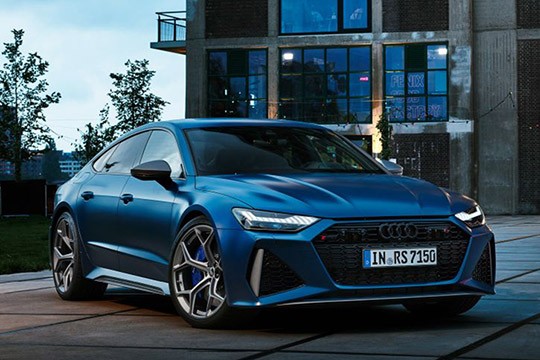AUDI RS7 Sportback Models/Series Timeline, Specifications & Photos
First production year: 2013
Engines: Mild hybrid, Gasoline
Body style: Wagon (station wagon, estate, combi, touring)
In late 2022, Audi unveiled the RS7 performance, the most powerful to that date version of the RS7, and besides the engine upgrades, there were also other parts that were improved.
While BMW and Mercedes-AMG offered sedans for their M 5 and E63 executive sedans, Audi placed its bets on the station wagon of the A6, the RS6, and the four-door coupe RS7. The RS7 was, in fact, more of a hatchback at a larger scale. Something that neither one of Audi's direct competitors didn't have in their offers.
The RS7 performance version didn't hide its power and boasted a front lower grille, side scoops, side sills, and the rear diffuser finished in matte gray. In addition, the standard 21" alloy wheels were a statement about the car's performance. There was also a set of 22" alloys on the options list. Thanks to their design, these wheels exposed the large brakes. In addition, Audi introduced two new colors with the performance version, the Ascari Blue and the matte Dew Silver.
Inside, the carmaker offered a pair of high-bolstered bucket seats at the front and a split-folding bench in the rear. While it was possible to fit three people on the rear bench, it was profiled just for two occupants. In addition, it sported RS7 lettering embroidered on the seatbacks. At the front, the Alcantara materials were offered in a choice of three colors: gray, red, and blue.
But the most significant modification was under the skin, where the 4.0-liter powerplant received a power upgrade. In addition, the carmaker installed a new, lighter center differential that could transfer the torque between the front and rear wheels faster than the regular RS7.
The RS7 Sportback might be the answer for those who want RS6 Avant performance, but they appreciate a coupe-like bodywork more than the sleeper look of a station wagon. This is why Audi dropped the RS6 powerplant under the hood of the A7 and the result is the RS7 Sportback.
The RS7 is 40 mm (1.6 inches) wider than its non-RS sibling, the A7 Sportback. Actually, only the hood, the front doors, and the tailgate are the same body panels. Every other part is different and the total length now sits at 5 meters (197.2 in).
Upfront, over the redesigned front bumper, we can standard LED headlights, which can be improved with a pair of RS matrix laser headlights, with dark bezels. Of course, the taillights are also full-LED. At the rear, under the redesigned bumper, there is one oval exhaust tip on each side, marking the sporty character of the RS7. The rear spoiler installed on the tailgate raises up automatically above 100 kph (62 mph), or can be moved up or down from a touch of a button.
The engine is the same 4.0-liter V8 from the RS6 Avant and offers a mild-hybrid system with a belt-driven starter generator. The total output is 600 hp and 800 Nm (590 lb-ft) of torque. The energy is sent to the all-wheel-drive system via an 8-speed automatic gearbox. The traction is based on a fully mechanical center differential, which sends torque to the front and rear axles spread in a 40:60 ratio. The 0 to 100 kph (0-62 mph) sprint is completed in 3.6 seconds, and the top speed is 305 kph (189.5 mph).
Audi made the RS7 for those who didn't want the RS6, which was available only as a station wagon, and the result was a supercar dressed as a fastback, four-door coupe.
The A7 was the four-door (actually five) coupe of the A6. They shared the platform, drivetrains, and powerplants. Audi made that shape to compete with the BMW 6-Series Grand Coupe and the CLS from Mercedes. Its strategy worked, but when an M and AMG improved the other two German premium carmakers lineups, Audi had to answer properly and introduced the RS version for the A7 resulting in the RS7.
With its modified front fascia, which sported a honeycomb, singleframe grille, and the wide functional scoops on the lower apron, the RS7 was not as subtle as the RS6 Avant. Unlike its sibling, the S7, which sported silver door mirrors and A-pillars, the RS7 had these elements in body color. At the back, the carmaker added two large oval exhausts.
Inside, it wasn't as subtle as on the outside. The carmaker added the RS7 badge inside the tachometer dial, on the steering wheel, and embroidered on the front seats' seatbacks. Its dashboard, center console, center stack, and door cards featured a carbon-fiber trim, which amplified the sporty sensation of the nearly two-ton monster. Despite being a fierce highway runner, it was practical as well. Its 60/40 split-folding rear bench increased the trunk volume from 535 liters (18.9 cu-ft) to 1,390 liters (49 cu-ft).
Under the hood, the carmaker installed a 4.0-liter twin-turbo powerplant paired to a standard eight-speed automatic gearbox. Its all-wheel-drive system featured a sport rear differential. The RS7's customers could opt for the standard air suspension or a classic, metallic one with adaptive dampers.


